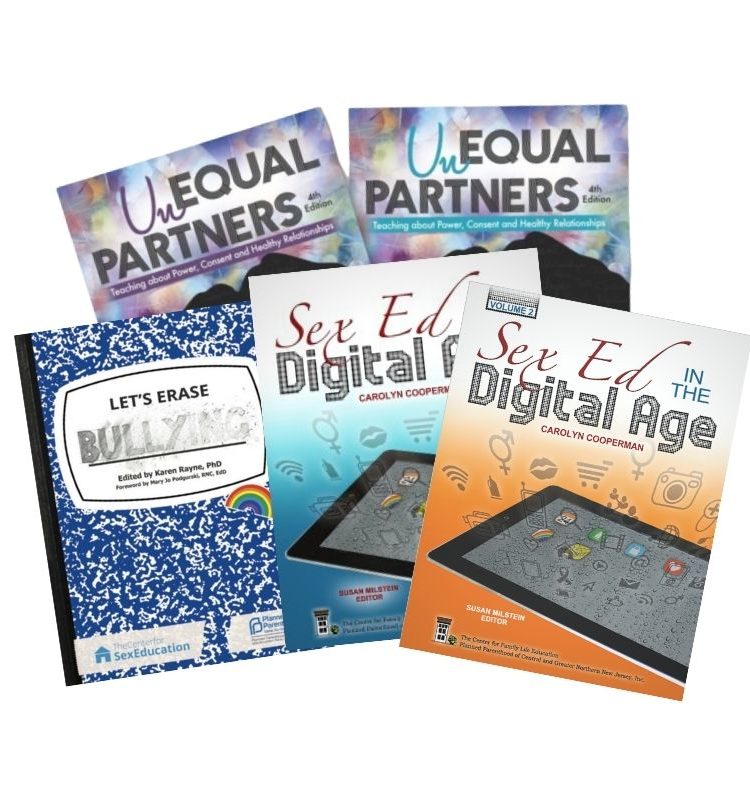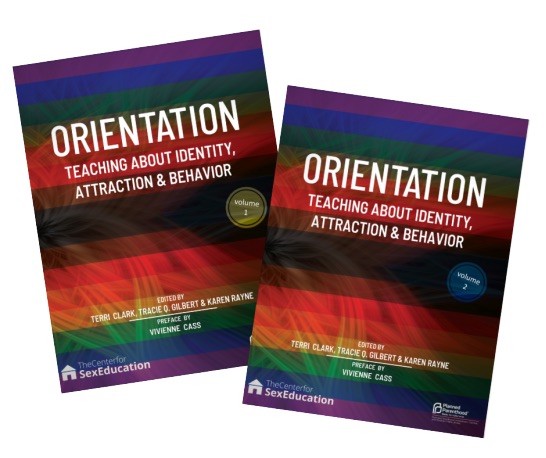Let’s Erase Bullying $59

Table of Contents for Let’s Erase Bullying
- Foreword by Dr. Mary Jo Podgurski
- Introduction
- How to Use Let’s Erase Bullying
- Principles for Sex Education
- Creating A Supportive Environment for Learning About Sexual Health and Bullying
- Lesson Essentials
Section 1: Introduction to Bullying
1. Everybody Has Drama: Part I: Finding Alternatives
2. Everybody Has Drama: Part II: Finding Help
3. Cornering the Problem
4. Courageous Bystanders: Everyday Heroes
5. Conformity and Individuality
6. Talk It Out to Work It Out
7. A True Friend: Assessing Power and Control in Friendships
Section 2: Cyberbullying
1. Mindfulness Matters: Acting Purposefully in a Digital World
2. Rallying Against Bullying
3. Staying Cool Under (Peer) Pressure: Using Digital Education Tools to Model Assertive Communication Skills
Section 3: LGBTQ+ Bullying
1. Getting Better All the Time: Teaching with the “It Gets Better” Videos
2. A Lesson on Homophobia and Teasing
3. Fighting Homophobia
4. Engaging Generation Z in Peer-Driven Advocacy: Promoting an Inclusive School Environment for LGBTQ Youth Through Project-Based Learning
Section 4: Intra-Relationship Abuse and Bullying
1. Holes in Condoms and Flushing Pills: Relationship Abuse and Reproductive Coercion
2. Warning Signals: Recognizing Clues to an Unhealthy Relationship
3. Sex: A Decision for Two
Introduction to Let’s Erase Bullying
By Karen Rayne, PhD
Bullying is receiving increased attention, including more research, more school-based interventions, and more compassion regarding the negative ramifications of being bullied. Almost one-fourth of all students report being bullied during the school year. While that may seem like an overwhelming number, it is not one that is inevitable. By standers have a substantial effect in reducing the instances of bullying. This manual provides suggestions and resources to empower both youth who are bullied and bystanders to end the cycle of violence and to educate bullies on the devastating impact of their actions.
In addition to addressing bullying as a general concept, this manual addresses cyberbullying, bullying because of perceived gender and sexual identities, and bullying that manifests as intimate partner violence. These three areas of bullying are included in this manual, in addition to a more general section on bullying, because they warrant special attention.
Cyberbullying, or bullying that uses digital media as the means of communication, happens in the online environment of social media, text messages, apps, email, chat rooms, comments sections, and every other form of digital communication. As most young people use technology as a common communication tool in all of their relationships, it is critical to address digital bullying. In fact, almost half of all young people have experienced cyberbullying.
Youth who identify as, or are perceived as, LGBTQ+ are at increased risk for bullying along with other forms of violence and hatred. While the broader culture has become more accepting of these identities, there are individuals and groups who are upset about those cultural developments. As a result, bullying of people who identify as LGBTQ+ has actually increased. This is particularly true for people who are gender nonconforming and/or who identify as transgender.
Intimate partner violence, while not always falling within the purview of bullying, maintains aspects of bullying in that a stronger person wields physical, social, and emotional power and control over a weaker person. The particular topics addressed in this section (reproductive coercion and sexual coercion) both address pressure used by a more powerful person against a weaker person.
Distinct lesson plans and education as laid out in this manual are a critical component of reducing bullying. However, schools and other youth-serving organizations must take deliberate steps to create an anti-bullying culture. As Dr. Podgurski said so eloquently in the Foreword, “A systemic approach to bullying prevention involves an entire school system, from parents and administration, to faculty and administrative staff, to cafeteria workers, to bus drivers, to maintenance/grounds staff.” When an entire community comes together to offer support for young people, a culture of bullying can be prevented. All staff need education, training, and resources so they know how to stand on the side of safe educational spaces and how to prevent and combat bullying.
I hope that you find this manual useful in erasing bullying, co-creating a culture of support, and ultimately increasing empathy.
Foreword to Let’s Erase Bullying
By Dr. Mary Jo Podgurski, CSE
“My 12-year-old is being bullied.”
“My gay teen wants to attend cyberschool. We’re all tired of the bullying.”
“We’re new to the area and my child is afraid to ride the bus because she’s bullied. She’s a big girl and the other girls mock her.”
“I have an autistic teen. It hurts me to know he eats lunch alone. I know he’s being bullied but he can’t tell me.”
“I hate going to school since I came out as trans. Most of my teachers use correct pronouns, but two refuse to do so. It’s almost like they purposefully say the wrong pronoun to humiliate me in front of the class. I think they’re bullies, even though they are adults.”
I can’t count how many times I’ve heard words like these. Details change, but there’s a common theme: a young person is isolated, vilified, and harmed. Three of the most common young people targeted for bullying are disabled, LGBTQ+, and overweight youth; statistical patterns of bullying become irrelevant when a young person or parent feels alone.
Occasionally, a tragic suicide draws national attention to bullying; for me, it’s personal. I’ve had the honor and joy of serving young people as an educator and counselor since the ’70s. Bullying is real to me, not an abstract concept or an academic topic. Survivors of bullying attend the Common Ground Teen Center I run. They participate in my sexuality education classes and serve as peer educators. They are young parents in our pregnant and parenting teen program. They are LGBTQ+ youth at our weekly GSA (Gay Straight Alliance). They matter.
When I’m troubled by something bigger than myself, I seek knowledge. I became an Olweus Bullying Prevention Program certified trainer to address bullying in my community. Olweus appealed to me for its systemic approach, its extensive research, and its hands-on trainings. I was a seasoned educator in my 50s when I was certified, yet I still learned much.
I learned:
- Words matter when bullying is the subject. Labeling helps no one. Instead of using the word “bully,” I say, “student who bullied.” In lieu of “victim,” I say, “student who was bullied” or “survivor.” Dignity and respect must be constant; parents must be given a voice.
- Young people who bully others aren’t typically insecure, but rather are self-confident, feeding on bystander approval to gain power. Adults model bullying behavior in schools, in families, in sports, and in politics.
- Educators are key to preventing bullying. A systemic approach to bullying prevention involves an entire school system, from parents and administration, to faculty and administrative staff, to cafeteria workers, to bus drivers, to maintenance/grounds staff. Only educators can model bullying prevention in the classroom, however. Each teacher needs to be introspective and honest with themselves; a teacher’s silence gives tacit approval to bullying and passive body language is a potent method of communication.
- Young people need a voice in bullying prevention. Teens create peer culture. Teens can move from observers to the type of bystander who becomes an ally. Teens need to be empowered to make change in their own culture.
Each educator has a responsibility to become informed about bullying prevention. Educators teaching sensitive topics surrounding sexuality, relationships, and intimate partner violence are in a position to make a real difference in their students’ lives if they incorporate bullying prevention messages into their lessons.
The cutting-edge topics in this manual touch sensitive areas and address the needs of our most vulnerable learners. I was struck by how much the manual’s messages embody the best in bullying prevention while targeting areas pertinent to sexual health. Bullying prevention should be a foundation of each sexuality educator’s lessons; weaving bullying prevention information into a sexual health topic can empower learners and open the door to potentially life-saving conversations.
Awareness of bullying prevention goes beyond formal education. As adults, we need to be advocates for bullying prevention that works. One-time school assemblies and policies with the potential to discriminate may do more harm than good. Be an ally to isolated individuals; be there.
I am thrilled to recommend this manual. Section 1, “Introduction to Bullying,” looks at friendships, intimate relationships, unequal partners, communication, and the challenge of achieving individuality in a culture where conforming is often the norm.
Section 2, “Cyberbullying,” addresses the online challenges young people face regarding their self-worth and well-being. The lessons in this section provide practical strategies for dealing with life in the digital age.
Section 3, “LGBTQ+ Bullying,” looks at homophobia and the very real dangers LGBTQ+ youth face daily. Bystanders can be empowered to fight homophobia. These lessons are models for allies.
Section 4, “Intro-Relationship Abuse and Bullying,” provides a window into bullying within an intimate relationship, examining consent, decision-making, coercion, and relationship abuse.
I am grateful to Dr. Karen Rayne, to the manual’s contributors, and to The Center for Sex Education for making this innovative manual a reality. Open these pages and learn, as I did, how to be proactive in protecting each young person.
Endorsements for Let’s Erase Bullying
Special requests?
We can accomodate! For bulk orders or paying by purchase order, please click below to get in touch:



